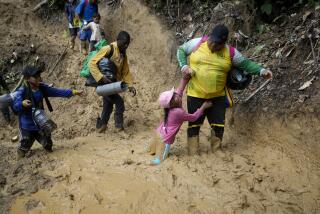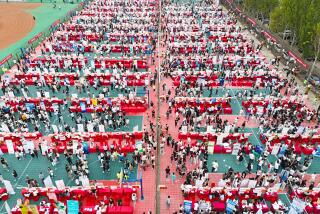Morocco Wants Children Out of Workshops and Into School
- Share via
FEZ, Morocco — A group of tourists wanders through narrow streets, marveling at the age-old production techniques of the craftsmen.
But a few steps off the beaten track, in hole-in-the-wall workshops and ramshackle basements, adolescents and children work with urgency and concentration. In these under-regulated workshops, you either keep up the pace or go hungry.
Many young workers are from families that have migrated to the city, fleeing lower incomes in the countryside. Some are as young as 7, earning around $6 for a six-day week.
These youngsters have been targeted in a drive by the United Nations children’s agency UNICEF and Moroccan authorities to persuade artisans to stop hiring children under 12 and release those already employed for a few hours of schooling each week.
Officials also attempt to win over the hearts and minds of parents, visiting them at home.
Under legislation passed in 2000, all Moroccan children under 15 should be in school. In 1993, Morocco ratified the U.N. Convention on the Rights of the Child, which says children should be protected from economic exploitation.
But there are no plans at present for a strict clampdown on child labor.
Officials justified this approach by pointing to the harsh realities of a country of 30 million in which 20% of the population lives in extreme poverty.
“We remind the artisans of the terms of the U.N. convention,” said Laamoumri El Ghali, an official with the Handicrafts Ministry in Fez. “But if we strictly enforced the law, many workshops would have to close and we would have a lot of unemployed artisans.”
Families dependent on child labor, it is argued, would fall into extreme poverty if it were abolished overnight.
In a dilapidated stone building, two men were using improvised welding equipment to make traditional copper teapots.
El Ghali was the first official to visit, they told him. In response to his query about accidents, a boy in an orange T-shirt was fetched from next door. He pulled up his shirt to reveal burn tissue covering most of his chest and stomach.
Three years ago, a leak from a gas canister flared up as he was lighting a gas ring. The scar tissue still gives him trouble. El Ghali noted down his details -- Badr El Mbarek, age 15, burned.
Metalworking is the most hazardous field, followed by jewelry and mosaic-making, because of the chemicals used. Children working with slipper-makers are exposed to vapors from the glue, and dust causes respiratory problems for those working in the pottery sheds.
Actors from a nongovernmental organization are being used in the workplace to press home the problems of using child labor.
In one scene performed before a group of artisans employing children, a hard-pressed mother begged a craftsman to take on her young son as an apprentice: “Just teach him the trade,” she implored. “You needn’t pay him.”
There was embarrassed laughter from the audience. They recognized the emotional blackmail of the mother, who a few weeks later would demand payment for her child’s labor.
A reference to the effects of chemicals used in mosaic-making drew sheepish laughter. “Your eyes are as red as traffic lights!” the mother scolded the boy later. “Don’t tell me you have started smoking hashish!”
The message was that child labor may be cheap and endorsed by social attitudes, but it harms the child.
Rached Sibaoueih, 35, a carpenter in Marrakesh, said some parents still liked to place their child with an artisan over the school holidays.
“They prefer him to learn a skill than to hang around the streets picking up bad habits,” he said.
Another carpenter, Mustapha K., said he would take his own son out of school to learn the trade when he reaches 12.
“I know boys who studied until they were 22 only to find themselves unemployed now, being supported by brothers or cousins who are artisans,” he said.
Through the 1970s and ‘80s, child labor was a taboo topic in Morocco, says social anthropologist Chekib Guessous, author of a new book on the subject.
It was linked to the politically sensitive question of educational provision. Poorer families used to regard schooling as of little use in the real world.
But attitudes are changing.
Mokhsin, 8, who has worked in a Fez pottery shop since his father and brothers lost their jobs, said: “When I go home, my friends who go to school say working is good for nothing. They make me cry. If I don’t study, it’s as if I don’t exist.”
Just 234 of the thousands of children working in the Fez craft sector were enrolled this year in the classes coordinated by UNICEF.
Attendance is sometimes patchy, with employers pleading full order-books. When they do turn up for classes, some of the children are too exhausted to concentrate.
There has been little pressure from political parties, trade unions or wider public opinion for any stricter stance on child labor.
A rare press comment Nov. 1 called for those employing children to be penalized.
“It’s time to move on to action,” wrote the Fez correspondent of Aujourd’hui le Maroc newspaper, noting that neither awareness-raising days nor official measures had stopped the exploitation.
More to Read
Sign up for Essential California
The most important California stories and recommendations in your inbox every morning.
You may occasionally receive promotional content from the Los Angeles Times.













